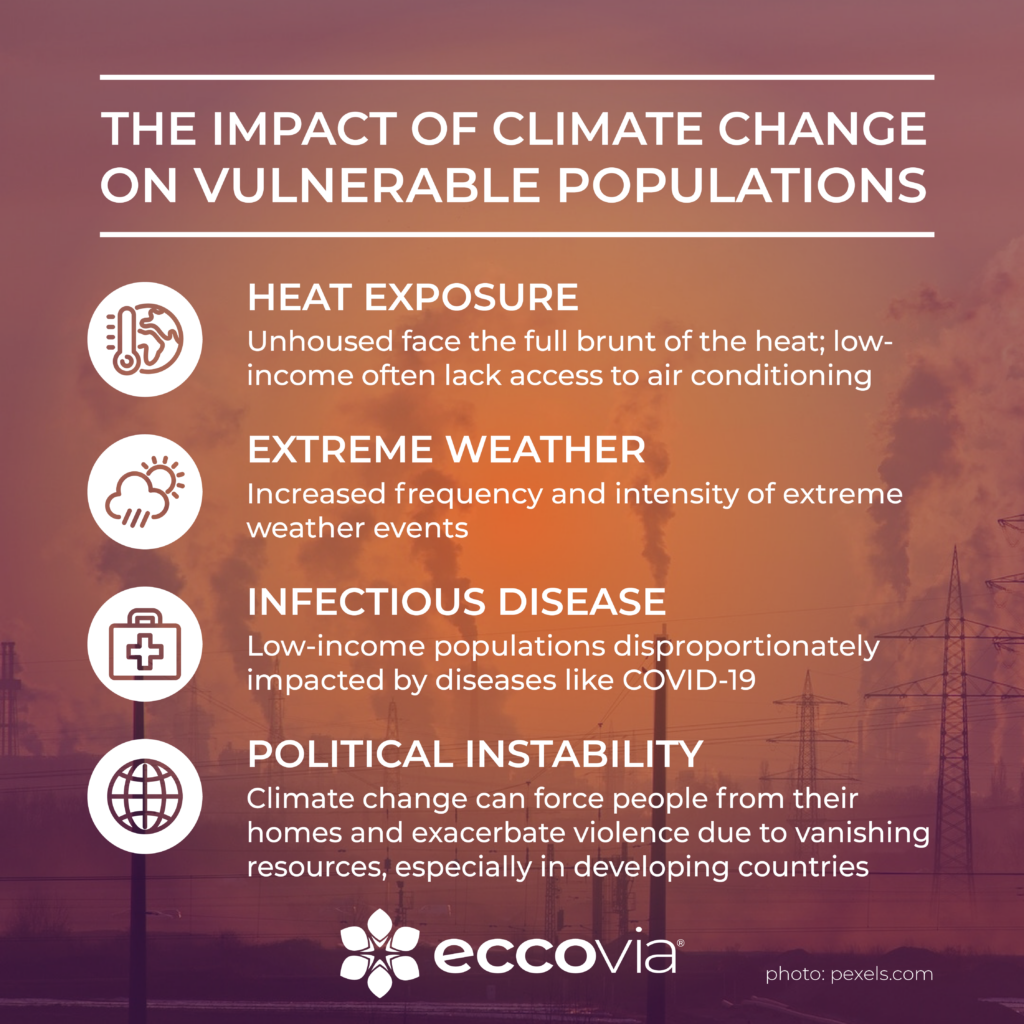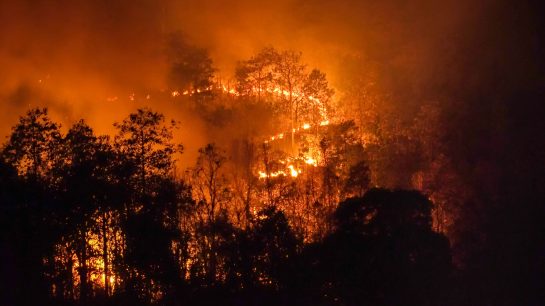Climate change is affecting human life economically and sociopolitically, and vulnerable populations often have little recourse to protect themselves from the elements. How should communities and homeless services agencies react to the recent heat waves across the United States, and what can we do to prepare for future crises?
July 2023 turned out to be the hottest month on record, according to climate scientists. Large swaths of the Midwest, Southwest, and Mountain West have reached triple-digit temperatures (above 100 degrees Fahrenheit) for longer than normal, causing death and increased power usage, the latter of which only contributes to carbon emissions, which only further spurs climate change.
So what does a warming climate mean for the sector of health and human services? It will create more climate refugees, loosely defined as anyone who is displaced as a direct or indirect result of climate change. An increased focus on social determinants of health (SDoH) will be necessary for helping clients beat the heat.
The Effects of Climate Change on Vulnerable Populations
A 2021 report from the Environmental Protection Agency (EPA) shows how “the most severe harms from climate change fall disproportionately upon underserved communities who are least able to prepare for and recover from heat waves, poor air quality, flooding, and other impacts.” There are many effects caused by climate change, but the most prominent ones that affect homeless populations are:

Increased Heat
Climate change is leading to higher average temperatures, heatwaves, and more extreme hot days and nights. This increased heat can cause heat exhaustion and other health problems, particularly for vulnerable populations, such as the elderly, children, the unhoused, and those with pre-existing health conditions.
Extreme Weather Events
Climate change is expected to increase the frequency and intensity of extreme weather events like hurricanes, cyclones, wildfires, and storms. These events can cause significant damage to infrastructure, which homeless populations heavily rely on.
Wildfires in particular have a way of increasing home prices; for example, two major California home insurers announced they would not accept new home insurance applications because of increased risk of wildfires. This shortage of available insurance is likely to only destabilizing the housing market, which would only exacerbate the state’s homelessness crisis.
Infectious Disease
In addition to direct health risks from heatwaves and extreme events, climate change can also contribute to the spread of infectious diseases. Warmer temperatures can expand the range of disease vectors like mosquitoes, leading to the spread of diseases.
One prime example is the Covid-19 pandemic, where it was actually lower temperatures that strongly correlated with increases in Covid-19 infections because of less physical distancing.
Political Instability
The effects of climate change can exacerbate or lead to political instability. As resources become scarcer, conflicts arise, leading to displacement and refugee crises.
One example cited by PBS is El Salvador: “scores each year leave villages because of crop failure from drought or flooding, and end up in cities where they become victims of gang violence and ultimately flee their countries because of those attacks.”
Low-income individuals, including unhoused populations, are more likely to live in areas where:
- childhood asthma diagnoses increase with 2°C of global warming;
- temperature-related deaths increase with 2°C of global warming;
- available labor hours (and therefore employment) decreases with 2°C of global warming; and,
- the highest percentage of land is projected to be lost to flooding, with 50 cm of sea-level rise.
Climate change is affecting and will affect everyone to some degree, but people experiencing homelessness—and people in developing countries—will likely bear the brunt of the damage.
Reducing Climate-Related Harm for Homeless Individuals
Given these previously-stated projections, what are homeless service providers and communities to do? Well, here are some ideas for mitigating climate change-related harm.
Safety Measures for Extreme Temperatures
Implementing a robust emergency response plan can improve the safety of people experiencing homelessness during extreme weather events. This plan may involve securing additional temporary shelter spaces, providing transportation to safer locations, and maintaining emergency supplies of food, water, and first aid. During heatwaves, communities can set up cooling centers, distribute water, and provide access to sunscreen and shade.
During cold spells, service providers can distribute warm clothing and blankets, and ensure clients have access to heating spaces, at the least. Case workers should also learn first aid responses for hypothermia, heat stroke, and the like.
Also, where possible, service providers can work to improve the infrastructure of their facilities to better cope with extreme weather. This could involve installing air conditioning or heating systems, or improving insulation.
We also encourage communities to refer to the National Health Care for the Homeless Council’s resource on emergency preparedness for multiple weather situations.
Client Education and Advocacy
Service providers can educate homeless clients about the risks associated with extreme weather conditions, such as heat stroke in extreme heat, or hypothermia in extreme cold. This could involve providing information on symptoms of these conditions and advising clients on what actions to take, via outreach teams, with secure messaging apps, or during intake and assessment. Communities can also raise awareness and advocate for policies that take into account the needs of homeless individuals in climate change adaptation and disaster-risk-reduction strategies. This could involve lobbying for the inclusion of homeless populations in city-heatwave or cold-snap response plans, for instance.
Partnerships with Service Providers and Businesses
Collaborating with local health clinics and hospitals can ensure homeless clients have access to medical care during extreme weather events. This collaboration can help to prevent and treat health conditions related to extreme heat or cold. Health Facilities Management, a publication of the American Hospital Association, highlighted how one hospital prepared for the effects of extreme heat with the following steps:
- Developing partnerships and communications with several hospitals to split the costs of necessary equipment;
- Establishing service agreements with regional utility providers wherein it could electively switch to power intake from their generators, to mitigate brownouts and grid instability, which helped the entire city with a less volatile power grid; and,
- Establishing service agreements with business partners “to ensure Carondelet Health [was] first in line when its facilities needed rental chillers or generators during a systems failure.”
Data Warehousing Solutions
Service providers can leverage technologies like data warehousing to better analyze, predict, and respond to the needs of clients during extreme weather events. Data analytics can help to identify those most at risk, and inform more effective strategy and resource allocation.
For example, a data warehouse can serve as a single source of truth when it ingests data from various sources indirectly and directly related to homeless management information systems (HMIS):
- Directly-related data sources include public health dashboards, child-welfare services, workforce services, criminal-justice information, HMIS, housing authority data, and the like; and,
- Indirectly-related data sources could include weather data, traffic, emergency response history, geographic data, and so on.
One powerful use case for data warehousing could look like this: say you have a statewide heatwave that’s affecting pockets of your homeless-client populations.
- Without a data warehouse, you’d have to manually identify which geographic areas are most affected by high heat and cross-reference against known homeless encampments.
- With data warehousing and analytics, you could access real-time weather data and quickly check against geographic data of homeless encampments, and then more quickly send outreach teams to provide resources to those areas where the heat is the worst.
Climate Resilience in Homelessness Services
Community care coordination, smart use of technology, and advanced planning are the only ways we’re going to be able to mitigate the worst effects of climate change on homeless and otherwise vulnerable populations. Service providers of health and human services are now forming larger coalitions of networks more than before because they’ve realized the value in coordinating care with the smart use of data, instead of relying on spreadsheets and emails to get the job done.
While climate change continues, it’s up to us as communities to focus on what we can control. That’s why we at Eccovia have released ClientInsight, a data warehouse solution that focuses on community intelligence and data maturity to provide the ability to make better, more data-driven decisions. If you find your community needs a solution that helps you focus on improving client outcomes, schedule a demo with one of our experts today!



